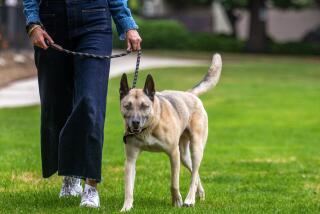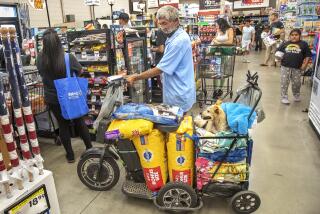Owners Can Train Their Dogs to Be Well Behaved
- Share via
To be man’s best friend, a dog must be socialized and schooled--taught with understanding and affection. According to Howard Carson of Canyon Country, trainer of large dogs, many people create “problem dogs” that all too often end up on the street or in animal shelters.
Matthew Margolis of the National Institute of Dog Training in El Monte recommends starting training even at the young age of 7 weeks; he also maintains that you can indeed teach an old dog new tricks.
Margolis believes that there are three no-nos when it comes to establishing the all-important owner-dog relationship: “No hitting; no yelling; no punishing.” These actions do not produce positive solutions, and they do not establish the sought-after response natural to a disciplined animal--the desire to please.
The following suggestions are offered for solving the most common problems owners have with their dogs:
Barking--Even though most cities have enacted anti-barking ordinances that provide for punishing offenders (owners and pets), excessive barking is still the most common complaint. According to Margolis, excessive barking can indicate “aggressiveness, anger, loneliness, playfulness or a demand for something.” The owner must determine the cause and eliminate the stimulus. For instance, if your dog always barks when hungry and you plan to be out of town or have to work late, ask a neighbor to feed the dog.
If an animal has a tendency to bark when left alone, Margolis suggests putting the dog on a leash well in advance of your departure, but not deviating in any way from your usual departure routine. Leave. Quietly return so that the dog is unaware that you are back. Wait. Do nothing until the dog goes into his barking cycle. At this point, quickly approach, take hold of the leash, give it a gentle but substantial jerk and shout a firm “No!” The dog probably will be caught off guard and quiet down. Now comes the time for praise and reward--a reconditioning technique.
When outside stimuli--another dog, a noise, a teasing squirrel--start the barking, this same discipline can be used.
Biting--All trainers agree that biting can never be tolerated--even in play. Many owners believe a puppy’s nibbles are cute, but this behavior must be discouraged from the beginning. Once again, positive communication with the animal must be achieved. Carson, who specializes in Rottweilers, Dobermans and German shepherds, advises rewarding good behavior but consistently showing disapproval of unacceptable mouthing. Margolis, who authored “When Good Dogs Do Bad Things” (Little, Brown), says that biting can be traced to four sources: inherited behavior (their ancestors had to hunt to live), poor socialization, environmental influences and owner behavior.
No well-socialized dog wants to displease his owner. Training should begin early. Teach a puppy to understand that his food and prized possessions--toys and bones--may at times be taken from him; do this by talking to him gently, in a friendly, reassuring manner, while you briefly touch or move a toy or food. This practice must be started early so that it becomes routine and is a positive conditioning move.
If you have a problem biter, for whatever reasons, there are some positive measures to take. Do not ever reward aggressive behavior with praise of any kind. Be there always to correct a dog’s every aggressive move--the noise made by a can filled with pebbles works well. It is difficult, Margolis says, to change a highly territorial dog. The best you can do is change the form his aggressiveness takes.
Obedience training goes a long way toward solving the problem of biting. Once obedience-trained, the dog will bark rather than bite, or, on command, will stand firmly instead of lunging. Since biting is so unacceptable, some punishment may be required. David Taylor, in his book “You and Your Dog” (Alfred A. Knopf), says that you should “think carefully why you are using the punishment and be sure in your own mind that the animal will understand why it is being punished. There’s no point in scolding it for something it has done much earlier. Any retribution must be speedy; otherwise it is just counterproductive.”
Jumping--This is a problem particularly with large dogs. Carson suggests raising your knee with a slight forward push and a strong “No!” The jumping dog will feel that he has caused the resistance and back off. Set up situations and be consistent!
Soiling--All dogs can, and of course should be, housebroken. Only dogs with a medical problem cannot achieve success. Training should begin at 7-8 weeks. Margolis stresses a five-point program: 1. Drinking water schedule. 2 Consistent feeding schedule. 3. Removal of all odors (using white vinegar and water). 4. Confinement (dogs will not soil their living quarters). 5. Praise. If your dog begins to eliminate in your presence, put him on a leash and quickly take him outside to the area where he is permitted to relieve himself. Praise him the minute he gets there, whether or not “he goes.” If he continues to use this designated area as a bathroom, praise him lavishly. Never take him outside for play during this housebreaking period. Let him learn this is a toilet, not a playground.
Stealing Food--The table is set, and the hors d’oeuvres are out--out of the picture! What does one do when there is a four-legged thief? You can’t blame the dog--the food smells good, tastes better and it’s free! The problem is what to do to prevent the burglary.
Margolis suggests you put fresh meat on the table and put a leash with a slip collar on the dog. When the dog goes for the food (why wouldn’t he?), jerk the leash to the right and say “No!” in a loud, firm tone. Praise him for not taking the food (he, restrained, obviously was unable to). Repeat the correction technique, rewarding him each time. Test him afterwards to assure his success--and yours.
Phobias--All animals, including humans, are subject to fear, beginning at the third week of life. When phobias develop in the 8- to 9-week period, the recovery rate is slower. A nervous or shy dog is most likely to develop phobias. Trainers suggest that shy, fearful dogs not be placed behind a closed door. Instead, use a puppy or toddler gate that provides vision beyond the confinement area. Also, when leaving the dog alone, leave signs of life--a light, a radio or tape recording of the owner’s voice. Even a “blankie,” so adored by toddlers, can help.
Chewing--According to animal researchers John Paul Scott and John L. Fuller, chewing is a natural activity closely associated with eating. Dogs are highly social, and it is emotionally and physically stressful for them to be left alone. (It is rare that a dog chews in front of a family.) Chewing is a release from tension, so if you want to restrict this behavior, reduce the tension: Don’t confine the dog in a tightly closed area; be sure to provide a good diet and exercise program; reduce the chances for boredom, and remove temptations (socks, shoes, leather goods, etc.).
Sue Myles, a Newport Beach trainer, suggests giving the dog something interesting to relieve boredom. She recommends getting a sterilized bone from the pet shop (or boiling one from the supermarket) and filling it with peanut butter or prepared spreadable cheese. Trying to retrieve the goodies is tempting for the dog and is challenging and time-consuming. Also, provide interesting toys and teething-relievers. Washcloths soaked in cold water and placed in the freezer are inexpensive helpers. In severe cases of chewing, make the items that are attractive to your dog unpleasant to taste.
Begging--We appreciate our dog’s liking the finer things in life, but we abhor his asking for them at dinner parties. Also, dog food offers a scientifically balanced diet. “People” food is not suitable or sufficiently nutritious. Feed your dog on schedule (yours) and be sure his diet is well formulated. Never give him table scraps or feed him at the table. Be certain he knows his feeding spot. If the dog already habitually begs, don’t despair. Leash the dog, wait for the unacceptable whimper or whine. Then jerk the choke collar or use a shake can or squirt bottle reinforced with a firm “No!” When he obeys, be sure to praise--but not reward with the food!
Car Behavior--Chasing cars used to be a serious and difficult problem. Now, if the leash law is obeyed, this problem should not exist. However, riding peaceably and peacefully in the car continues to be a source of concern. Actually, it comes down to obedience training.
Trainers recommend transporting dogs in a dog crate. It may look like a cage, but to a dog, it is really a den, providing security and comfort. Dogs calm down quickly in a crate, says Margolis, and their confinement is safe for them and the occupants of the vehicle.
Digging--Who among us dog owners has not just planted seedlings, only to have them uprooted and brought to us by our pet? Some dogs simply dig holes as deep as they want or need to in order to escape under a fence. Some dogs dig to create a cool spot, some to bury feces (to obscure scents), others to bury bones for a future meal. Some dogs even seem to dig to expend excess energy. Sometimes the simplest solution is to provide a dog house and/or a dog run as a means of confinement. Margolis suggests these ideas: Fill a hole with water (this won’t work with water-loving dogs); put rocks in his favorite hole; place his feces in his chosen digging area; squirt him with a garden hose; blow up balloons and fill his choice holes with them (attach them to a rock as an anchor). Another trick is to soak newspapers sprinkled with cayenne pepper, alum or Tabasco sauce. He will hate the taste on his paws.
In general, the best way to handle behavior problems is to build good communication with your dog. Let him know what you expect, and reward him when he obeys your command. Teach him love, security and respect for your laws and orders.






